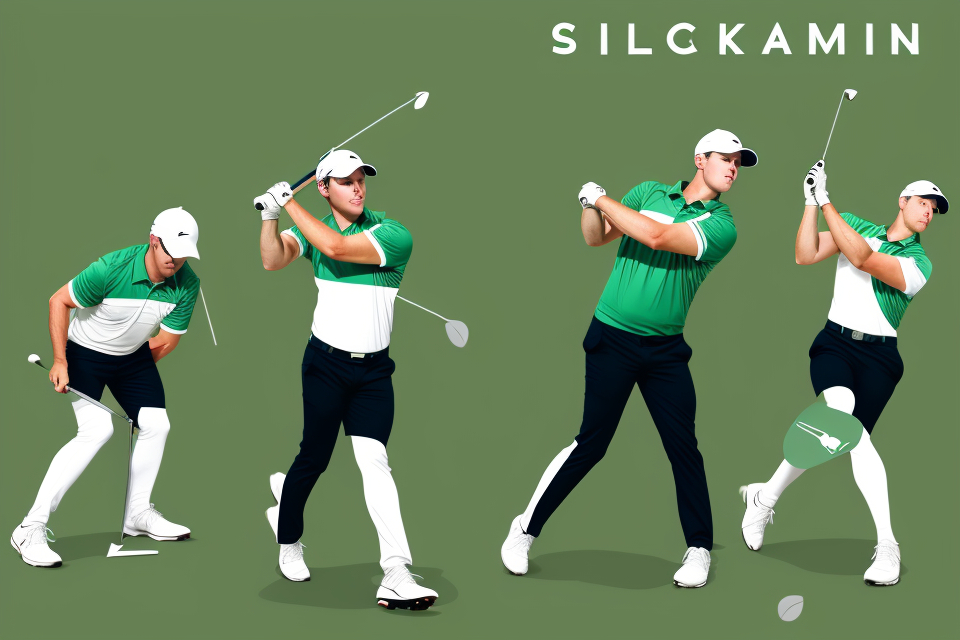
Golf is a sport that requires precision, technique, and skill. One of the most important aspects of the game is the swing, which determines the distance and direction of the ball. Many golfers struggle with hitting the ball high enough to achieve the desired distance and accuracy. In this article, we will explore some tips and techniques to help you improve your swing and hit the ball higher in golf. Whether you are a beginner or an experienced golfer, these techniques will help you take your game to the next level. So, let’s get started and learn how to improve your swing and hit the ball higher in golf!
Understanding the Golf Swing
The Importance of a Proper Grip
Achieving a proper grip is crucial for hitting the ball higher in golf. The grip is the foundation of your swing, and it affects the trajectory and distance of your shots. Here are some tips for achieving a correct grip:
- The Correct Grip Pressure: Applying the right amount of pressure on the golf club is essential. A light grip pressure allows for a smooth swing, while too much pressure can cause tension and affect the shot’s accuracy. Experiment with different grip pressures to find the one that works best for you.
- The Correct Grip Position: The grip position impacts the direction and power of your shots. A neutral grip, with the hands slightly ahead of the club’s handle, promotes a natural swing and helps you hit the ball higher. Experiment with different grip positions to find the one that feels most comfortable and allows you to swing smoothly.
- The Correct Grip Alignment: Ensure that the clubface is aligned properly at address. A misaligned grip can lead to shots that slice or hook, causing a loss of distance and accuracy. Check your grip alignment by looking down at the club from above and making sure the clubface is pointing straight ahead.
- The Correct Grip Size: The size of your grip can affect your swing and shot accuracy. A grip that is too small or too large can cause discomfort and tension during your swing. Choose a grip size that feels comfortable in your hands and allows for a natural swing.
By focusing on these tips, you can improve your grip and hit the ball higher in golf. Remember, a proper grip is the foundation of a successful swing, so take the time to experiment and find the grip that works best for you.
The Role of Your Body Position
Correct body positioning is a crucial aspect of hitting the ball higher in golf. The body positioning should be such that it allows for maximum power and control over the swing. Here are some key tips for setting up your body for a better swing:
- Stand with Your Feet Shoulder-Width Apart: This stance allows for a balanced and stable base, which is essential for a smooth and powerful swing.
- Keep Your Knees Bent: Bent knees provide flexibility and stability, enabling you to transfer your weight effectively during the swing.
- Shift Your Weight: As you swing, shift your weight slightly onto your front foot, allowing you to use your legs and hips to generate power.
- Relax Your Arms: Keep your arms relaxed and away from your body, allowing for a smooth and powerful swing.
- Tuck Your Chin: Tucking your chin into your neck can help you maintain a steady gaze and keep your head still during the swing.
- Align Your Shoulders: Make sure your shoulders are square to the target line, which will help you maintain a consistent and accurate swing.
- Bend Your Wrists: Bending your wrists can help you generate power and control, allowing you to hit the ball higher and further.
By following these tips, you can improve your body positioning and increase your chances of hitting the ball higher and further in golf.
Finding the Right Swing Path
The Connection Between Swing Path and Ball Flight
The relationship between your swing path and ball flight is crucial to understanding how to hit the ball higher in golf. The path your club travels during the swing directly influences the trajectory of the ball. In order to hit the ball higher, it’s essential to find the ideal swing path that promotes a steeper angle of attack and generates more spin.
- How your swing path affects ball flight
Your swing path affects ball flight in several ways. For example, if you swing on an inward path, the ball will likely fly lower and shorter due to the reduced loft angle of your club. Conversely, if you swing on an outward path, the ball may fly higher and farther, but it will also likely have a right-to-left curvature. A neutral or slightly inward swing path is generally preferred for hitting the ball higher with control.
- The ideal swing path for hitting the ball higher
To hit the ball higher, you should aim for a swing path that is slightly inside or neutral relative to your target line. This path will allow you to make contact with the ball on a steeper angle, generating more spin and elevation. It’s important to note that the ideal swing path varies depending on the club and shot you’re using, so it’s crucial to understand the optimal path for each situation.
Experimenting with different swing paths and making small adjustments can help you find the ideal path for your game. Practicing on a golf simulator or using a launch monitor can provide valuable data on ball flight and trajectory, allowing you to fine-tune your swing path for higher, straighter shots.
Practicing Your Swing Path
One of the most effective ways to improve your swing and hit the ball higher in golf is by practicing your swing path. A proper swing path can help you make solid contact with the ball and achieve greater distance. Here are some drills to improve your swing path and common mistakes to avoid when practicing.
Drills to Improve Your Swing Path
1. Inside-to-Outside Drill
To practice an inside-to-outside swing path, stand with your feet shoulder-width apart and grip the club with your dominant hand. Make a backswing that finishes with the clubhead pointing at the target. Then, swing the club from the inside to the outside of your body, finishing with the clubhead pointing at the target line. Repeat this drill several times to ingrain the correct swing path into your muscle memory.
2. Outside-to-Inside Drill
To practice an outside-to-inside swing path, stand with your feet shoulder-width apart and grip the club with your dominant hand. Make a backswing that finishes with the clubhead pointing at the target. Then, swing the club from the outside to the inside of your body, finishing with the clubhead pointing at the target line. Repeat this drill several times to ingrain the correct swing path into your muscle memory.
3. Delayed Rotary Drill
To practice a delayed rotary swing path, stand with your feet shoulder-width apart and grip the club with your dominant hand. Make a backswing that finishes with the clubhead pointing at the target. Then, rotate your hips and shoulders toward the target, keeping your arms and hands slow and steady. This drill will help you develop a smooth, controlled swing with a delayed rotary action.
Common Mistakes to Avoid When Practicing Your Swing Path
1. Swinging Too Inside or Too Outside
Avoid swinging too inside or too outside on your shots. Both of these errors can lead to mis-hits and poor contact with the ball. Instead, focus on a neutral swing path that allows you to make solid contact with the ball and achieve greater distance.
2. Lifting Your Head During the Swing
Lifting your head during the swing can cause you to lose your balance and make poor contact with the ball. Keep your head down and your eyes focused on the ball throughout the swing to maintain a consistent swing path and achieve greater distance.
3. Rushing the Swing
Rushing the swing can cause you to lose control of your body movements and make poor contact with the ball. Instead, focus on a smooth, controlled swing that allows you to make solid contact with the ball and achieve greater distance.
By practicing your swing path with these drills and avoiding common mistakes, you can improve your swing and hit the ball higher in golf.
Improving Your Swing Speed
The Importance of Speed in a High Golf Swing
When it comes to hitting the ball higher in golf, one of the most important factors is swing speed. The faster you swing, the higher the ball will go. However, simply swinging faster is not always the answer. It’s important to have a balanced and efficient swing that produces power without sacrificing accuracy.
Here are some tips for increasing your swing speed:
- Practice your swing regularly: The more you practice, the more efficient your swing will become, and the faster you will be able to swing without sacrificing accuracy.
- Use a driver with a larger clubhead: A larger clubhead will give you more leverage, which can help you swing faster without sacrificing control.
- Increase your muscle strength and flexibility: Stronger muscles and increased flexibility will help you swing faster and more efficiently.
- Work on your swing mechanics: Make sure you are using the correct swing mechanics, as poor mechanics can slow down your swing and prevent you from hitting the ball as high as you want.
- Increase your aerobic fitness: Golf may not seem like a sport that requires a lot of cardiovascular fitness, but being in good shape can help you swing faster and more efficiently.
Remember, it’s not just about swinging faster, it’s about swinging faster while still maintaining control and accuracy. With practice and the right techniques, you can improve your swing speed and hit the ball higher in golf.
Developing a Consistent Swing Speed
Consistency is key when it comes to developing a powerful and accurate golf swing. A consistent swing speed allows you to control the ball’s trajectory and hit it with precision. To develop a consistent swing speed, follow these steps:
- Start with a proper grip
- The grip is the foundation of your swing, so it’s essential to get it right. Hold the club with your dominant hand at the bottom of the grip and your non-dominant hand near the top. Ensure that your palms are facing each other and that your thumbs are parallel to the ground.
- Warm up before you swing
- Warming up your muscles before you swing can help prevent injury and improve your performance. Try some light stretching or some swings with a lighter club to get your muscles ready for the challenge.
- Use proper body positioning
- Good body positioning is crucial for a consistent swing speed. Stand with your feet shoulder-width apart, with your weight evenly distributed on both feet. Keep your knees slightly bent and your weight on your toes, ready to explode into your swing.
- Maintain a smooth rhythm
- A smooth rhythm is essential for a consistent swing speed. Start with a slow, controlled backswing and then explode into your downswing, hitting the ball with power and precision. Avoid rushing or jerking your swing, as this can lead to inconsistency.
- Practice your swing
- Consistency takes practice, so be sure to spend time on the driving range working on your swing. Start with some basic swings to get a feel for your body positioning and swing speed, and then gradually increase the difficulty of your drills.
- Focus on your form
- Pay attention to your form as you swing, and make adjustments as needed. Avoid using your arms or shoulders to generate power, as this can lead to inconsistency. Instead, focus on using your core and legs to create a powerful, consistent swing.
- Incorporate drills into your practice routine
- Drills can help you develop a consistent swing speed by focusing on specific aspects of your swing. For example, try some drills that focus on developing a smooth rhythm, such as the “waggling” drill, where you swing the club back and forth without hitting a ball. You can also try drills that focus on body positioning, such as the “t-drill,” where you practice your swing with a target in mind.
By following these steps, you can develop a consistent swing speed and hit the ball higher and farther on the golf course. Remember to practice regularly, focus on your form, and be patient as you work towards your goals.
Using Your Lower Body to Swing Higher
The Role of Your Lower Body in the Swing
When it comes to hitting the ball higher in golf, your lower body plays a crucial role. By engaging your lower body in the swing, you can generate more power and control your shots more effectively. Here are some key tips for utilizing your lower body to improve your swing:
- Keep your weight shifted towards your front foot: As you begin your swing, keep your weight shifted towards your front foot. This will help you maintain balance and stability throughout the swing, allowing you to make more powerful contact with the ball.
- Engage your core muscles: Your core muscles are essential for maintaining a stable lower body during the swing. As you begin your backswing, engage your core muscles to provide a solid foundation for your swing.
- Use your hips to generate power: Your hips are a powerful source of energy in the swing. As you make contact with the ball, use your hips to generate maximum power and distance.
- Keep your lower body relaxed: While it’s important to engage your lower body in the swing, it’s also important to keep it relaxed. Tense muscles can lead to a loss of power and control, so be sure to keep your lower body loose and flexible throughout the swing.
By following these tips, you can use your lower body to swing higher and hit the ball further down the fairway.
Incorporating Lower Body Movements into Your Swing
Integrating lower body movements into your golf swing is crucial to achieving a higher ball flight. Your lower body, specifically your hips and legs, provide the power and stability needed to generate a powerful and accurate swing. Here are some tips on how to incorporate lower body movements into your swing:
- Maintain a wide stance: Stand with your feet shoulder-width apart, allowing for a stable and balanced base. This will enable you to generate power from your lower body during the swing.
- Engage your core: Activate your core muscles as you begin your swing, which will help you maintain balance and control throughout the motion. A strong core will also allow you to transfer power from your lower body to your arms and hands.
- Use your hips to initiate the swing: As you address the ball, shift your weight onto your back foot and rotate your hips in a clockwise direction (for right-handed golfers). This will create torque and generate power for the swing.
- Pivot your lower body: As you swing through the ball, allow your hips to pivot and turn, transferring power to your upper body and arms. This will help you maintain a smooth and efficient swing.
- Keep your lower body engaged: Throughout the swing, maintain a strong connection between your lower body and upper body. This will help you generate power and control the direction of the ball.
Incorporating these lower body movements into your swing will not only help you hit the ball higher but also improve your overall accuracy and consistency on the course. Additionally, it’s important to maintain good posture and balance throughout the swing, as this will allow you to use your lower body effectively and avoid any unnecessary tension or strain.
Remember, incorporating lower body movements into your swing takes practice and patience. It’s important to focus on the proper mechanics and techniques, and work with a golf instructor or coach to develop a personalized swing that suits your body type and style. With time and dedication, you’ll be able to improve your swing and hit the ball higher in golf.
FAQs
1. What are the main factors that affect the height of a golf shot?
There are several factors that can affect the height of a golf shot, including the angle of attack, the ball’s position on the clubface, the ball’s initial velocity, and the spin rate. A higher angle of attack, a more forward ball position, and a higher initial velocity can all contribute to a higher shot. However, it’s important to note that a higher shot may not always be desirable, as it can lead to a loss of control and accuracy.
2. How can I adjust my swing to hit the ball higher?
One way to hit the ball higher is to use a more upright swing plane. This can be achieved by shifting the ball back in your stance and making a more vertical swing motion. Another way to hit the ball higher is to use a more shallow angle of attack, which can be achieved by using a lower lofted club or by making a more handsy swing. It’s important to experiment with different techniques to find what works best for your swing and playing style.
3. What are some common mistakes to avoid when trying to hit the ball higher?
One common mistake when trying to hit the ball higher is to use too much upper body movement, which can lead to a loss of control and accuracy. Another mistake is to try to hit the ball too hard, which can lead to a slice or a pull. It’s important to maintain a smooth, rhythmic swing and to focus on making solid contact with the ball. Additionally, it’s important to use the correct technique for your playing style and to avoid overcompensating in an effort to hit the ball higher.
4. How can I improve my swing to hit the ball higher?
Improving your swing to hit the ball higher requires a combination of physical and mental practice. Physical practice includes working on your swing mechanics, such as your swing plane, tempo, and ball position. Mental practice includes visualizing your swing and focusing on making solid contact with the ball. It’s also important to practice under different conditions, such as windy or rainy weather, to build your confidence and develop your ability to handle different situations. Additionally, it’s important to seek feedback from a qualified instructor to identify any flaws in your swing and to receive personalized advice on how to improve.


